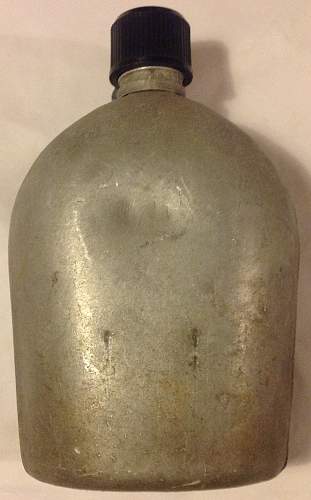Canadian 51 Pattern Webbing
Article about: Following the Second World War Canada increasingly turned to the US for military inspiration rather than the UK. In 1951 they introduced a new webbing set that was clearly inspired by both t
-
 Canadian 51 Pattern Webbing
Canadian 51 Pattern Webbing
Following the Second World War Canada increasingly turned to the US for military inspiration rather than the UK. In 1951 they introduced a new webbing set that was clearly inspired by both the British P37 set, and the US M1910 sets- elements from both sets were combined to make something distinctly Canadian:

The 51 pattern set is not common in the UK and I am slowly going through each component in detail on my blog, I have only covered a few so far but the links are below.
The webbing set is built around a belt, that combines the eyelets of the US M1910 with the brass rear buckles of the 37 pattern:

These were connected to a pair of shoulder braces, the webbing here is much thinner than previous webbing sets:

The basic pouches are inspired by the 37 pattern set, but are much larger and attach to the belt with loops and a hook and tab:


More detailed photographs can be found on my blog here: https://hatchfive.wordpress.com/2016...g-basic-pouch/
The most obviously American element of the set is the canteen carrier (they also changed the nomenclature form the British ‘Water Bottle’ to the American ‘Canteen’), which again is similar to the US M1910 design, but with side buckles added:

More detailed information is available here: https://hatchfive.wordpress.com/2017...nteen-carrier/. Two different canteens were used, firstly an aluminium example:

This was found to split if the water in it froze, so a plastic version replaced it. Although it looks identical to US designed bottles the design actually originated in Canada and was introduced shortly before the US brought theirs into service. This is a very early 1960 dated example:

One unique feature of the set is the mess tin carrier, a specialist pouch just to hold a set of mess tins:

The mess tins are made of aluminium and slightly squarer at the corners than contemporary British designs:

The bayonet frog is a simplified version of the standard mills product, designed just for use with a spike bayonet rather than a long sword bayonet which was now obsolete in Canadian service:

Sadly I don’t have the small pack yet, but along with the large pack they are both based off the British 37 pattern design, with additional tabs attached to allow wire hangers to be fastened to hang extra pieces of equipment off the set:

The packs used ‘l-straps’ to attach them to the rest of the webbing sets:

The entrenching tool chosen for the set was again based off US practice, and a light canvas cover was produced with wire hangers to attach it to the belt or pack:

Although not strictly part of the 51 pattern set, the respirator haversack is closely associated with it and is of a uniquely Canadian design:

My thanks must go to a fellow collector, Andrew Iarocci, of Canada for his help in supplying me with most of this set. He has written an excellent paper on post-war Canadian webbing which can be viewed here: http://scholars.wlu.ca/cgi/viewconte...01&context=cmh
This pattern of webbing was very long lived, mainly because the succeeding 64 pattern set was so rubbish, and components remained in use well into the 1980s.
-
-

Thanks for the pictures, I find the European developments of 37 pattern webbing very interesting, but there is little information out there on it unfortunately.
-

One P51 item that did see widespread foreign use was the holster for the Inglis HP 35 pistol-most Western armies had at least a few by the end of WW2 and more were sold by the Canadians afterwards-the holster was still issue here in the 1980s even after the Inglis version was largely replaced with later FN made HP 35s.
-
-


by
Warspite

Thanks for the pictures, I find the European developments of 37 pattern webbing very interesting, but there is little information out there on it unfortunately.
Yes, unfortunately.
If you are interested I have several of the 1950s manuals on the Danish Webbing equipment in digital copies?
-

That would be great thanks...although I will mostly be looking at the pictures as my Danish is non existent!
-

Very interesting post , thanks for sharing .
-


by
Warspite

That would be great thanks...although I will mostly be looking at the pictures as my Danish is non existent!
Then perhaps photos are best?
I will PM you for an e-mail! 
-

Thanks for sharing Warspite, this is a great write-up (as usual)! I had no idea that the plastic canteen design originated in Canada...very interesting!
Although I keep the focus of my collecting very narrow, I have often been tempted by the P51 set! I like how certain uniquely Canadian variants from the P37 set were included, such as the small frog for the spike bayonet and the economy L-straps that lacked reduction weaving at the hook attachment...
Similar Threads
-
In Equipment and Field gear
-
In Equipment and Field gear
-
In Equipment and Field gear
-
In Equipment and Field gear
-
In Equipment and Field gear
 Posting Permissions
Posting Permissions
- You may not post new threads
- You may not post replies
- You may not post attachments
- You may not edit your posts
-
Forum Rules



















 .
.






Bookmarks